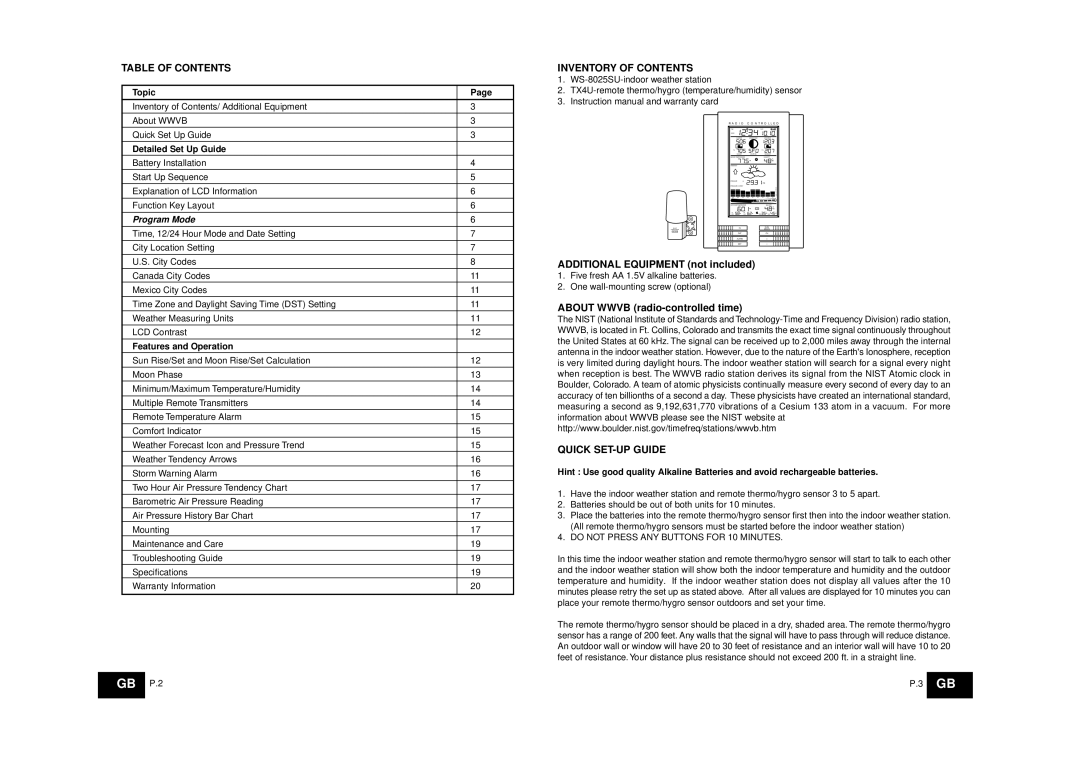
TABLE OF CONTENTS
Topic | Page |
|
|
Inventory of Contents/ Additional Equipment | 3 |
About WWVB | 3 |
Quick Set Up Guide | 3 |
|
|
Detailed Set Up Guide |
|
Battery Installation | 4 |
Start Up Sequence | 5 |
Explanation of LCD Information | 6 |
|
|
Function Key Layout | 6 |
Program Mode | 6 |
|
|
Time, 12/24 Hour Mode and Date Setting | 7 |
|
|
City Location Setting | 7 |
U.S. City Codes | 8 |
|
|
Canada City Codes | 11 |
Mexico City Codes | 11 |
Time Zone and Daylight Saving Time (DST) Setting | 11 |
|
|
Weather Measuring Units | 11 |
|
|
LCD Contrast | 12 |
Features and Operation |
|
Sun Rise/Set and Moon Rise/Set Calculation | 12 |
Moon Phase | 13 |
Minimum/Maximum Temperature/Humidity | 14 |
|
|
Multiple Remote Transmitters | 14 |
|
|
Remote Temperature Alarm | 15 |
Comfort Indicator | 15 |
Weather Forecast Icon and Pressure Trend | 15 |
Weather Tendency Arrows | 16 |
Storm Warning Alarm | 16 |
|
|
Two Hour Air Pressure Tendency Chart | 17 |
|
|
Barometric Air Pressure Reading | 17 |
Air Pressure History Bar Chart | 17 |
Mounting | 17 |
Maintenance and Care | 19 |
Troubleshooting Guide | 19 |
Specifications | 19 |
Warranty Information | 20 |
|
|
GB P.2
INVENTORY OF CONTENTS
1.
2.
3.Instruction manual and warranty card
R A D I O C O N T R O L L E D
|
| SUNRISE |
|
|
| MOON PHASE |
| MOONRISE | +1 | ||||
|
|
|
|
|
|
|
|
|
|
|
|
|
|
|
| SUNSET |
|
|
| LOCATION |
|
| MOONSET |
| |||
INDOOR TEMPERATURE |
|
| HUMIDITY |
| |||||||||
|
|
|
|
|
|
|
|
|
|
|
|
| % |
|
|
|
|
|
|
|
|
|
|
|
|
| RH |
TENDENCY |
|
|
|
|
|
|
|
|
|
|
| ||
PRESSURE | rel |
|
|
|
|
|
|
| |||||
|
|
|
|
|
|
|
| inHg |
|
|
| ||
PRESSURE HISTORY |
|
|
|
|
|
|
| ||||||
|
|
|
|
|
|
|
|
|
|
|
|
|
|
|
|
|
|
|
|
|
|
|
|
|
|
|
|
|
|
| 0 | +0.2 | +0.5 | +1 | +2 |
| +4 | ||||
OUTDOOR TEMPERATURE |
|
|
|
| HUMIDITY | % | |||||||
|
|
|
|
|
|
|
|
|
|
|
|
| |
|
|
|
|
|
|
| 2 |
|
|
|
|
| RH |
IN | SUN/ |
MOON | |
433 MHz |
|
OUT | CH |
ALARM | + |
SET | – |
ADDITIONAL EQUIPMENT (not included)
1.Five fresh AA 1.5V alkaline batteries.
2.One
ABOUT WWVB
The NIST (National Institute of Standards and
QUICK SET-UP GUIDE
Hint : Use good quality Alkaline Batteries and avoid rechargeable batteries.
1.Have the indoor weather station and remote thermo/hygro sensor 3 to 5 apart.
2.Batteries should be out of both units for 10 minutes.
3.Place the batteries into the remote thermo/hygro sensor first then into the indoor weather station. (All remote thermo/hygro sensors must be started before the indoor weather station)
4.DO NOT PRESS ANY BUTTONS FOR 10 MINUTES.
In this time the indoor weather station and remote thermo/hygro sensor will start to talk to each other and the indoor weather station will show both the indoor temperature and humidity and the outdoor temperature and humidity. If the indoor weather station does not display all values after the 10 minutes please retry the set up as stated above. After all values are displayed for 10 minutes you can place your remote thermo/hygro sensor outdoors and set your time.
The remote thermo/hygro sensor should be placed in a dry, shaded area. The remote thermo/hygro sensor has a range of 200 feet. Any walls that the signal will have to pass through will reduce distance. An outdoor wall or window will have 20 to 30 feet of resistance and an interior wall will have 10 to 20 feet of resistance. Your distance plus resistance should not exceed 200 ft. in a straight line.
P.3 GB
